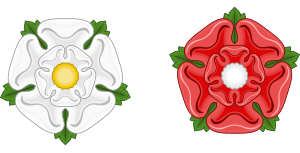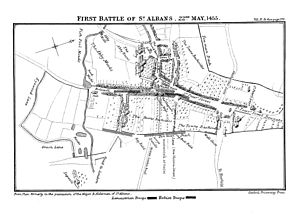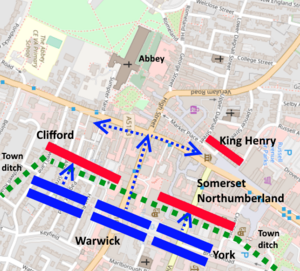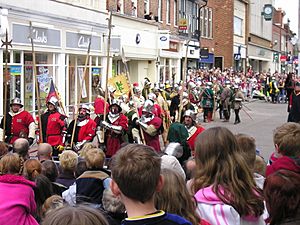First Battle of St Albans facts for kids
Quick facts for kids First Battle of St Albans |
|||||||
|---|---|---|---|---|---|---|---|
| Part of the Wars of the Roses | |||||||
 |
|||||||
|
|||||||
| Belligerents | |||||||
| Commanders and leaders | |||||||
| Strength | |||||||
| 3,000–7,000 | 2,000 | ||||||
| Casualties and losses | |||||||
| 60 | 100 | ||||||
The First Battle of St Albans happened on May 22, 1455. It took place in St Albans, a town about 22 miles (35 km) north of London. This battle is often seen as the start of the Wars of the Roses in England.
Richard, Duke of York, and his friends, the Neville Earls of Salisbury and Warwick, fought and won. They defeated the King's army, which was led by Edmund Beaufort, Duke of Somerset. Somerset was killed in the battle. After the battle, King Henry VI was captured. A special meeting of important people (called a Parliament) then chose Richard of York to be the Lord Protector, which meant he would rule the country.
Contents
Why the Battle Happened
King Henry's Illness
In 1454, King Henry VI became very ill with a mental sickness. Because of this, Richard of York, who was the King's closest adult relative, was called back to court. York had been sent away to Ireland in 1447, almost like an exile.
Rivalry and Power Struggles
York's long-time rival was Edmund Beaufort, Duke of Somerset. Somerset was the King's favorite. He had been in charge of England's lands in France. But Somerset failed badly in France.
York then came back to London. Many nobles and ordinary people supported him. They saw that Somerset was not good at his job. York wanted Somerset to be held responsible for his failures. He also wanted to be recognized as the person who would become King if Henry VI had no children.
York's First Move
In 1452, York gathered an army. He wanted to force the King to deal with Somerset. The King wanted to avoid a fight. York's demands were agreed to, so he sent his army home.
However, York was then arrested and held prisoner for three months. The King was worried about causing more trouble because York was very popular. York was released after he promised not to fight against the King again.
York Becomes Lord Protector
Later, the English army lost a big battle in France. King Henry VI then had a complete mental breakdown. He could not do his job as King. Somerset tried to take control of the country. He wanted to become the Lord Protector.
But Somerset did not realize how much influence York had. Many nobles supported York, including his allies Richard Neville, Earl of Salisbury and his son Richard, Earl of Warwick. So, York was chosen to govern England as Lord Protector. He used this power to have the Duke of Somerset put in prison.
Family Feuds
During this time, two powerful families, the Percys and the Nevilles, were also fighting. The Percys were Earls of Northumberland. The Nevilles were very rich and held the titles of Salisbury and Warwick.
The Nevilles were also related to the Duke of York by marriage. Much of their fighting was over land and money. The Percys supported Somerset, and the Nevilles supported York.
King Henry Recovers
By Christmas 1454, King Henry got better. This meant York no longer had the official power to rule. Somerset was released from prison and got his old job back.
In April 1455, the King and his council decided to hold a big meeting in Leicester. York and his allies thought Somerset would accuse them of crimes at this meeting. So, they gathered their own armed groups (called a retinue) and marched to stop the King's group. They planned to meet them at St Albans.
Getting Ready for Battle
Messages and Marches
On May 18, the King and Somerset in London heard that York and his friends were marching south. They were coming down the Great North Road. Somerset told a church leader, Cardinal Thomas Bourchier, to order them to stop.
On May 20, York and the Earls of Warwick and Salisbury wrote a letter from Royston. They said they were loyal to the King. They claimed they only brought their forces to protect themselves from their enemies.
It's not clear if York wanted to march on London or capture the King on the way to Leicester. But Somerset called his allies to St Albans. He left London on May 21, perhaps because he feared Londoners supported York.
The Yorkists marched towards St Albans. On May 21, they wrote a letter directly to the King from Ware. That night, the King and Somerset were in Watford. The Yorkists were camped on the road between Ware and St Albans.
The Battle Begins
Setting the Scene
The King's army, called the Lancastrians, arrived at St Albans first. They had about 2,000 soldiers. Humphrey Stafford, Duke of Buckingham, was in charge. He placed troops along the Tonman Ditch and at the town's entrances to defend it. King Henry VI had made Buckingham commander at the last minute.
The Yorkist army arrived with about 7,000 soldiers. They camped in Keyfield, to the east of the town.
Talks and Tensions
Long talks began, with messengers going back and forth between the leaders. After a few hours, the Yorkists believed King Henry VI knew nothing about the letters they sent.
The Duke of York made his goals clear: he wanted Somerset punished, even executed. Demanding so much from the King was a risky move for York. Fighting against the King was considered treason. But York was popular, which made him confident.
The Surprise Attack
After several hours, Richard of York gave up on a peaceful solution. He decided to attack. Many of his soldiers might not have wanted to fight the King. But the King's flag (the Royal Standard) was not clearly visible. It might have even been leaning against a wall.
Most of Henry's soldiers were surprised by York's sudden attack. They expected a peaceful end, like what happened in 1452. The Yorkists tried to attack twice down narrow streets. They faced strong defenses near St Peter's Church, led by Lord Clifford. These attacks failed and many Yorkists were hurt.
Warwick's Bold Move
The battle did not last long, only about half an hour. The Earl of Warwick caused a big surprise. He led a group of soldiers through an unguarded part of the town. He used back lanes and gardens.
Soon, Warwick appeared in the market square. This is where most of Henry's soldiers were resting and talking. Many were not even wearing their helmets, showing they did not expect to fight. Warwick immediately charged with his forces. He quickly defeated the Lancastrians.
Key Deaths
Somerset knew York would not let him live. He tried to find safety at the Castle Inn. When the Yorkists surrounded the building, Somerset tried to fight his way out. He charged onto the main street, fighting past other soldiers. He killed four men before he was struck down and died.
The Earl of Northumberland was killed trying to reach the Castle Inn. Lord Clifford of Skipton, who was allied with Percy, was also killed in the main street.
Warwick's archers then shot at the men around the King. Several were killed, and the King and the Duke of Buckingham were injured. The Lancastrian soldiers defending the town realized they were surrounded. They feared an attack from behind, so they left their positions and ran away.
What Happened Next
York's Victory
In the First Battle of St Albans, fewer than sixty people died out of about 5,000 fighters. But for York and the Nevilles, it was a huge political win. York had captured the King and gained full power again. Somerset and the Nevilles' rivals from the north, Henry Percy, Earl of Northumberland, and Lord Clifford, were killed.
Some important people were wounded. These included Buckingham; Thomas de Courtenay, Earl of Devon; Jasper Tudor (the King's half-brother); and Somerset's son Henry Beaufort, Earl of Dorset. The brave and sudden attack by the 26-year-old Earl of Warwick helped him become famous. He earned the nickname "the Kingmaker" because of his power.
New Leadership
The day after the battle, York took King Henry back to London. A few months later, the Parliament officially named York the Lord Protector of England.
In Books and Plays
The famous writer Shakespeare wrote a play called Henry VI, Part 2. This play ends with the events of the First Battle of St Albans.
The book Trinity by Conn Iggulden is part of a series about the Wars of the Roses. It shows the battle as a moment where Richard of York was unsure. But it was a strong victory for the Neville family during their fight with the Percy family.
See Also




